THE CONSEQUENCES OF FAILURE
Alcor had achieved an exponential rate of membership growth by the time Jerry Leaf was cryopreserved. Since that time, there has been only modest growth of membership and in fact, in the years since 2007, membership growth has flattened.
The growth in the patient population has been similarly stunted with almost all increase being due to the cryopreservation of members, rather than at-need cases. The time when Alcor selected the highest quality at-need cases and delivered state-of-the-art care to those patients has now become a dim memory and, with one exception, the staff at Alcor has no experience with cases where immediate CPS, followed by prompt extracorporeal support, proceeded smoothly and without incident.
While it is easy to see the risks associated with at-need cases, particularly in the absence of careful vetting and strict adherence to predetermined (and protective) acceptance criteria, it is not so easy to see the even greater cost of foregoing them.
The quality of any complex procedure, medical or otherwise, is directly dependent upon the amount of experience staff have in doing it. Even highly trained and skilled personnel benefit from the experience gained by doing large numbers of cases. In fact, in medicine it has been a consistent finding that outcome in terms of morbidity and mortality in areas as diverse as open heart surgery, radiation oncology and HIV management improves steadily as a function of the number of procedures performed, or cases handled annually. The benefit of an increased case load is even more pronounced when the transition is made from a few cases per year to a few dozen per year, or more.
Absent a case load that keeps the cryopreservation team continuously busy, the only way to maintain even a semblance of competence is to carry out a program of animal research using a survival model that employs the same equipment, facilities and procedures that are employed in human cryopreservation cases. Absent this kind of day-in, day-out experience, it becomes impossible for staff to remember (or even know) where supplies are, how to calibrate, operate and troubleshoot equipment, and just as importantly, how to work together cohesively as a team.
The person leading that team and directing that research must be a competent and motivated „mountain climber‟ – otherwise the work will be a meaningless and gruesome exercise that achieves nothing but the demoralization of those participating in it.
SLIDE 139
Medical malpractice is a pretty common thing and as we have seen iatrogenic deaths are commonplace. That this is so, given the extensive training and mentoring physicians receive, should give us pause for thought. To become a General Practitioner in the UK or the US requires 12 years of postgraduate training. That is a huge commitment in terms of both time and money and it requires substantial motivation over and above the likely financial returns (in the UK or the US). This level of training and commitment act as a human filter – effectively removing many people who are not suited to the task of being physicians either as a result of „defects‟ in temperament or due to lack of intellect or skill.
However, this slide is misleading in that most of the real filtration has already taken place before a student enters medical school, or perhaps I should say more appropriately, is accepted to medical school. Roughly 95% of those who score well on the MCAT (Medical College Admission Test) or the UKCAT (UK Clinical Aptitude Test) and are subsequently admitted to medical school will finish it! Most of the separation of the wheat from the chaff takes place as a result of the MCAT/UKCAT scores and during the admissions process when the complete academic and behavioral profile of the candidate is evaluated.
What this means is that in practice only about 0.01% of the ~12% of graduating secondary school students who say they want to become physicians actually do so. Yet despite this high degree of selection and the extensive and costly training that follows, iatrogenesis is still a leading cause of death in both the UK and the US!
The implications of this for cryonics are pretty straightforward, although still hard to comprehend. In fact, most cryonicists simply refuse to believe what is on the previous slide and the 5 slides that follow.
All of these errors have occurred in the period of 1991 thru the present. Some, such as reversing the arterial and venous bypass lines or pouring sterile perfusate into a feces soiled container before perfusing it through a patient defy understanding even when it is accepted that they actually took place.
As we’ve just seen, as is the case with iatrogenic errors in medicine, mistakes happen even when practitioners are highly trained and carefully vetted. Without exception all of the well respected and highly qualified critical care physicians and surgeons whom I’ve known well have told me that in the course of their careers they made errors that cost patients their lives or resulted in serious and lasting morbidity. Indeed, I’ve made mistakes in caring for patients – the most serious of which involved errors in judgment that resulted in extra minutes of exposure to warm ischemia. In hindsight, both of these errors were easily avoidable by the simple expedient of insisting that reliable, trained cryonics organization personnel stay with the patient continuously after the start of Standby – regardless of how uncomfortable or problematic that might be for the family so long as our ability to provide Standby for the patient was not compromised.
The issue here is not that errors were made, but rather the underlying reasons, the frequency and the repetitiveness of the errors. Because of the enormous surface tension of water any air bubbles present in blood that are larger in diameter than the capillaries act as obstructions, or emboli. Thus, any air introduced into the arterial circulation of a patient receiving extracorporeal treatment will result in blockage or embolization of the arteries supplying the tissues with blood. Depending upon the amount of air and the area it embolizes, “pumping air” will result in either serious injury or death.
There is an old saying amongst perfusionists: “There are two types of perfusionists: those who have pumped air (into a patient‟s circulatory system), and those who will.” Particularly in the days before microbubble detectors with automatic interrupts to shut down flow and clamp the line supplying blood to the patient were developed and put into universal use, it was typically only a matter of time until any given perfusionist made a mistake that resulted in air being perfused into a patient. This might happen once in the course of a 20 year career during which time thousands of patients would have been perfused for an aggregate of tens of thousands of clinical hours.
It should also be understood that this aphorism includes incidents where introduction of air into the patient‟s circulatory system was arguably unavoidable. Here I‟d like to speak from personal experience. For about 8 years I was a hemodialysis technician both in the outpatient and acute care (ITU) setting. During that time I „pumped air‟ once. In this photo you see me doing hemodialysis in 1978 in Indianapolis, IN.
Microbubble detection equipment was available at that time, but not used at the institution where I worked. If you look at the schematic of the extracorporeal circuit used in dialysis you‟ll note that the leg of tubing connecting the patient‟s arm (artery) to the pump will be under negative pressure with respect to the atmosphere. In order for ~250 ml/min of blood to be withdrawn from the small caliber radial artery it is necessary to “suck” on the vessel. A consequence of this is that if there are any holes – even ones too tiny to see – in the tubing between the artery and the pump raceway air will enter. The dialyzer is inverted to serve as a bubble trap and there is yet another bubble trap before the blood is returned to the patient.
However, in the event the breach in the tubing is very small the resulting bubbles are microscopic and remain suspended in the blood even as it passes through the dialyzer and the bubble trap. Fortunately, in dialysis, we are returning blood to the venous circulation as opposed to the arterial circulation and that means that we have another safety feature – an air bubble filter in the form of the lungs. In the case I‟m discussing here there was a manufacturing defect in the arterial tubing set such that where the blood conducting tubing from the patient was joined to the pump raceway there was an incomplete seal. While the defect was invisible to the eye it was of sufficient size to allow the creation of a steady stream of microbubbles.
Approximately an hour into the treatment my patient began to complain of back pain and shortly thereafter shortness of breath (SOB). I rechecked the composition of the dialysate (blood washing solution) and checked the integrity of the circuit and found nothing amiss. However, as the back pain and SOB increased in severity I became extremely concerned. I realized that these were symptoms of micro-air embolism and I got a flashlight and carefully examined the tubing carrying blood back to the patient.
There was a barely visible fine whitish line at the top of some of the tubing. This was an accumulation of microbubbles that had risen to the top of the blood flowing through the tubing. The patient was immediately removed from the machine and recovered uneventfully and with no lasting harm.
Interestingly, it took the deaths of two patients from air embolism at that institution before ultrasonic air bubble detectors were purchased and added to the dialysis machines.
At left is the Travenol RSP dialysis machine that I began my career with and at right is a contemporary, highly automated hemodialysis machine. There are bubble traps on both the arterial and venous legs of the circuit and, of course, sophisticated ultrasonic microbubble detectors which will shut down the pumps and clamp the lines in the event air in the blood is detected. Additionally, these machines mix the dialysate in real time and ensure it is safe, calculate and implement water removal from the patient and otherwise carry out a myriad of tasks we never dreamed would be possible to „automate‟ in 1978.
Most of these advances came at the price of injury or death to patients who were treated with earlier generations of less sophisticated equipment. In 1978 universal chronic hemodialysis was only 6 years old in the US and I worked in one of the pioneering units making the treatment available to hundreds of patients who previously would have died. While some of the errors and shortcomings of that program were avoidable – many were not – they came as part of the price tag for implementing a then new and demanding technology on a scale previously undreamed of.
I understand errors and I understand their increased frequency and probable severity when implementing any complicated new technology. However, that is not the kind of failure I‟m talking about here in cryonics. The errors listed in these slides are not occasional but rather have become routine. Many are so base that they rise to the level of uncaring negligence.
Consider, for example, the case where a patient frozen to dry ice temperature was removed from dry ice storage and packed in water ice for air shipment to the cryonics facility because of airline restrictions on the amount of dry ice that could be used to refrigerate the patient in transit. Obviously, the patient thawed out before arriving at the cryonics facility and had to be refrozen. That means that tissue ultrastructure that was compressed and fragmented by initial straight freezing (but ostensibly locked in place by ice) would be returned to an aqueous and diffusible state – indeed a state characterized by intense fluid turbulence and “stirring” as concentrated pools of electrolyte diffused and re-equilibrated with the large masses of nearly pure water created by melting ice crystals!
When “average” cryonicists with no technical background or training are told that an “experienced” cryopreservation team leader took a patient out of dry ice and packed him in water ice they are uniformly appalled. Most cannot even understand how or why such a decision would be made by anyone, let alone a highly experienced cryonics caregiver. The same is true of many of the other errors just discussed.
But what is perhaps most shocking and seemingly inexplicable is the complete absence of any visible emotional reaction to these errors. When I discovered microbubbles in the venous return line of the patient I was dialyzing I had an immediate and strong reaction of fear and anxiety bordering on terror. Was the patient going to be all right? Had any permanent harm been done? Next came a wave of dread and worry that I had not delivered good care. Was there something I could have or should have done to prevent the injury to the patient? Could I have detected the problem sooner and acted to prevent some of the pain the patient experienced? With years of experience in medicine I’ve come to understand that this kind of emotional response is both normal and healthy. Strong feelings of discomfort in such situations are an essential part of not repeating the error. This empathetic and self critical emotional response to iatrogenic events seems to be completely absent in an increasing number of cryonics caregivers.
THE POD PEOPLE
As it turns out, I was not alone in having noticed this phenomenon. Aschwin de Wolf, then employed at Suspended Animation, Inc. in South Florida, was observing the same kind of behavior in a range of settings within the cryonics community. We both found it puzzling to the point of incomprehensibility that people who were delivering care to cryonics patients, in some cases medically trained professionals, could be so indifferent to errors that would, in a conventional medical setting, be career ending or at very least result in costly and traumatic litigation.
This phenomenon was most pronounced in non-cryonicist medical and technical professionals who had been hired to deliver care to cryonics patients. Superficially these individuals seemed to be competent and caring, but a closer examination revealed this to be anything but the case. This was especially surprising to me because I had hired and worked with non-cryonicist medical professionals in the past and had never encountered behavior even remotely like that which Aschwin first identified. In my correspondence with Aschwin I likened such individuals to the “Pod People” in the novel and films Invasion of the Body Snatchers.
While we speculated as to the possible motivation such people might have in becoming and remaining involved in delivering cryonics services (financial gain aside) we did not have to speculate as to what constituted a “Pod Person” in cryonics.
I want to credit Aschwin with first articulating most of these characteristics. He put into words things which I had observed myself, but had not fully understood and he identified a number of traits which I had not (at that time) observed myself. Since he was a cryonicist and he was in intimate contact with a culture of non-cryonicist “employee professionals” he was uniquely situated to observe and understand what was going on.
What he discovered was that people who are not cryonicists, and who are not selected and mentored to hold the values of people who are, behaved with uncaring indifference towards their patients. Not infrequently they actually held cryonicists in contempt considering them “chumps” or “fools” who are tilting at windmills while being consumed with an unnatural and cowardly fear of death.
It seems likely that these people are, in effect, recruited from and filtered out of the larger population of caring and empathetic health care providers and professionals. Absent a cohesive program of instruction and mentoring coupled with meaningful and results-driven day to day activity it would be difficult for anyone, cryonicist
or not, to remain engaged and committed to such a job. More to the point, few if any truly competent and caring persons (professional or otherwise) would accept and remain in a job where there was no “real” day-to-day work, no leadership, and no sense of mission or accomplishment. The kind of people who stay in such a position – especially given their active contempt for their employers and patients – are not psychologically healthy and are certainly lacking not only in compassion, but in work ethic.
Such “sterile” cryonics service operations led by people who lack vision, passion and commitment to cryonics themselves become highly efficient recruitment facilities for individuals who are, at best, borderline sociopaths.
In considering the history of cryonics it became all too apparent that the existence of Pod People was by no means a new phenomenon. As many people in cryonics over the years have observed, cryonics is a magnet for frauds and charlatans. Important extensions to that observation are that the majority of these individuals are also sociopaths and that they are routinely placed in positions of power by cryonicists and cryonics organizations.
This was true in 1966 when Robert Nelson arrived on scene and it has remained the case over the course of the subsequent four decades. The Olga Visser episode is only the most public of many, many other situations where deeply disturbed or frankly sociopathic individuals have been placed in positions of power and authority in cryonics, often within weeks or months of arriving on the scene!
Charles Platt chronicled the Visser saga very well:
http://www.cryocare.org/index.cgi?subdir=ccrpt10&url=visser.html, and I excerpt it only briefly here:
“On October 9th, 1995, readers of the sci.cryonics Usenet news group found themselves confronted with a strange report quoted from the South African Sunday Times. Supposedly, a 37-year-old cardiovascular perfusionist named Olga Visser had developed a new cryoprotectant that would enable human hearts to be frozen with virtually no damage, opening up exciting possibilities in the field of transplants, where organs usually have to be utilized within several hours after removal.
According to the Times Ms. Visser had started her cryoprotectant research two years previously when she helped to establish a heart-valve organ bank. Since valves can be cryopreserved using DMSO, she saw no reason why she shouldn’t be able to freeze whole hearts as well. Undeterred by her lack of knowledge of cryobiology, she consulted some experts, read some journals, and formulated her own cryoprotectant.
When she applied it to a pig heart, she reported “no damage” after the heart was rewarmed from liquid nitrogen. She described similar success with human heart tissue. Finally, “a rat heart was frozen, unfrozen, and then warmed by a special process–and started beating.
On September 8th an astonishing press release was issued jointly by Robert Ettinger, president of The Cryonics Institute (CI), and Steve Bridge, president of Alcor Foundation. Apparently Ettinger had been in discreet contact with Ms. Visser earlier in the year, had satisfied himself that her work was genuine, and then contacted Alcor.
The two groups formed an unprecedented secret alliance, contributing money to Ms. Visser’s research and ultimately flying her to Alcor’s facility in Scottsdale, Arizona. From August 30th through September 4th she demonstrated her experiment to Ettinger, Bridge, and several officers and directors of Alcor. She also gave CI and Alcor an exclusive license to use her present and future technology for cryonics applications.”
Ultimately, Visser was shown to be at best a misguided incompetent, and at worst a calculating con artist. When her „novel cryoprotectant‟ was put to an objective test at Alcor‟s facilities in February of 1997, it failed utterly to protect rat hearts against freezing. The net financial hit cryonics, including licensing fees paid to Visser, air fare, equipment purchases, and contributions to support her research was estimated by Alcor‟s then President Steve Bridge to be ~ $50K. Charles Platt sums it up aptly:
“Olga Visser’s brief passage through cryonics could still turn out to be a positive, salutary event if it reminds us to be more circumspect in the future. The next time a character out of a Heinlein novel turns up with a secret formula to fix our deepest fears, we may be a little less willing to pay cash for the recipe. We may even be a little more tolerant of the smart-asses who insist on reminding us that death is not an easy adversary, human biology is infernally delicate and difficult to preserve, and scientific rigor is a fundamental necessity, not a tiresome detail.”
SLIDE 153
Why this happens is not much of a mystery when it is examined in the context of other disciplines that command power over and control of peoples‟ lives. Medicine is not more overrun with psychopathic quacks than it is only because there is a profession of medicine, and there are also vast bodies of regulation and law with serious penalties attached, that govern its practice. Cryonics lacks all of these safeguards. Imagine, if you will, what the situation would be if such psychopaths were empowered to fly airplanes, captain ships, or design large, heavy structures such as multi-story buildings, bridges and dams? Indeed, when such people do succeed in occupying these positions disaster is the inevitable result.
Absent these controls, both internal and external, cryonics will continue to fall prey to quacks, frauds and most dangerously, sociopaths seeking positions of perceived psychological power and control with the bonus of being increasingly well paid for indefensibly careless and sloppy work.
SLIDE 154
Remember my example of repetitive iatrogenesis associated with ascites? Just a few weeks after I gave the first version of this lecture in 2008 it happened yet again, this time to cryonics pioneer (and my personal mentor), Curtis Henderson. See :
http://www.suspendedinc.com/cases/Stabilization%20and%20Transport%20Case%20Report%20CI95.pdf
and:
http://cryonics.org/reports/CI95.html.
I am a deeply committed and seasoned veteran of cryonics and I am telling you, without hesitation, that what happened to Curtis had a devastating impact on me. Anyone with medical sophistication who reads those two case reports will most likely just walk away and dismiss cryonics as perhaps an interesting idea with some potential – but clearly not one whose time has not yet come.
THE DUNNING-KRUGER EFFECT
Finally, how do we explain the actions of people in cryonics who are sincere and committed cryonicists and yet who take on technical tasks that are beyond their knowledge and skill sets with terrible results? Much of what happened to Curtis Henderson, particularly with respect to the errors made which prevented him receiving effective cryoprotective perfusion, fall into this category.
I believe the explanation lies in something called the Dunning–Kruger Effect (DKE) The DKE was put forward in 1999 by Justin Kruger and David Dunning and it posits that unskilled people make poor decisions and reach
erroneous conclusions, but their incompetence denies them the meta-cognitive ability to realize their mistakes. Thus, the unskilled suffer from an illusion of superiority, rating their own abilities as above average and much higher than they actually are. This leads to the situation in which less competent people rate their own abilities higher than more competent people.
It also explains why actual competence may weaken self-confidence. Competent people often falsely assume that others have an equivalent understanding and degree of skill or competence. A very simple and pithy way to sum up the DKE was put to me by a Russian cryonicist in an elevator at Birkbeck College: “We are so ignorant that we do not even know what we need to know, or what we don‟t know that we don‟t know – and that is a very dangerous situation indeed.”
The moment at which I first truly understood the role of the DKE in causing technical mayhem in cryonics was actually documented by a journalist doing a story on the Cryonics UK (CUK) group at one of their meetings, held in Brighton, in the fall of 2009. I had met the new leader of the group the year before, and was more than a little surprised to hear him dismiss the Alcor ATP in-field cardiopulmonary bypass system as being “simple to operate and something any mortician would be capable of immediately mastering.” When I incredulously asked if this young man had ever actually seen the ATP, he replied that he had and that it was “just a box with tubes going in and out of it.” I wasn’t the only one who was surprised at this assessment: there was a professional perfusionist in the room from a prestigious UK hospital, and he also (to put it mildly) took considerable issue with this assertion.
A year later I was having much the same discussion with what constituted virtually all of the technical people in the CUK group. After much heated and futile discussion, I proposed that rather than argue about it, they simply get the equipment and simulate putting a patient on bypass starting from the time pronouncement had occurred. At this point, I think it best to let the newspaper account pick up the narrative:
“Tim put any doubts to the back of his mind. He’s raring to go. “There’s a patient on the table dying. Hurry up, Darwin says.”
But, of course, the patient is imaginary. Tim takes the lead, explaining the ins and outs of the tubing to his less experienced fellow travellers. Meanwhile Mike Darwin watches, arms crossed reprovingly, his concern for the patient growing by the second.
“Right, I started timing you three minutes ago,” he says.
A good few minutes later Tim and his not-so-crack team are still working out where the red and blue bits plug into. “The only thing that goes wrong is if you switch it on without all the bits plugged in. It doesn’t like it and it has been known to go bang,” he says cheerily.
Darwin can’t contain himself. “If I had that kit here, I’d be scared shitless. Shitless. There are some critical things wrong with the setup of that circuit.” He tells the team they have made so many mistakes the patient would have suffered irreversible brain damage by now. Darwin suggests technology has regressed since he was in his cryonic prime 20 years ago.
But the water is pumping through the system, and Sinclair’s team are fully focused on saving their imaginary patient. Whatever Darwin tells them, they believe they are ahead of their time, not behind it.”
I will add one thing that the reporter didn‟t because he had left the room to photograph some of the other CUK members before he lost his light to the setting sun. And that is that the venous blood reservoir bag in the circuit of the ATP exploded due to a misplaced clamp. The reporter apparently missed the timid request made to the meeting‟s hostess, Sylvia Sinclair, for a mop and towels to clean up the water that was all over the kitchen.
While it is true that cryonicists often have no choice but to undertake to provide and deliver care for themselves, it is equally true that they should not attempt to do so in ways that make the situation worse for the patient than had they taken a simpler approach that was, in fact, within their ability to master.
I had spent most of that day at the meeting trying to convince the CUK group that rather than the ATP, what they really needed was to use a simple, inherently „safe‟ open circuit system open circuit system equipped with a microbubble detector and auto-line clamp, to start cryoprotective perfusion as soon as was logistically feasible and to follow that with cooling of the patient to dry ice.
My lack of success in persuading obviously sincere and concerned cryonicists to undertake a course of action that was at once simpler, easier, much less costly, and vastly more likely to benefit the patient speaks to the power of the DKE and to the over-optimism and lack of realism that is endemic to cryonicists, the same over-optimism and lack of realism that makes them easy prey for con men and sociopaths.
End of Inherent Failure Mechanisms and Risks and of Lecture 2

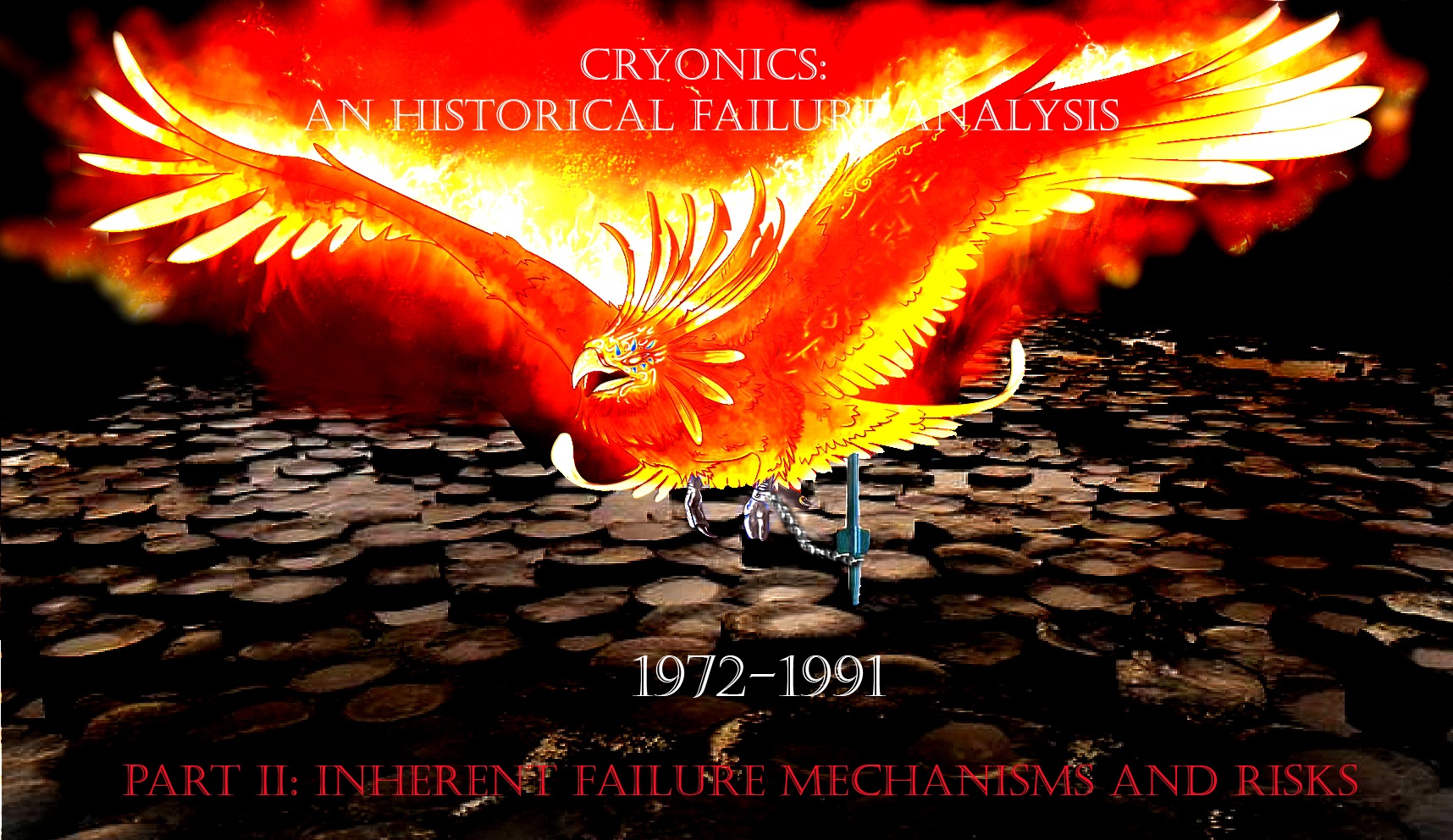
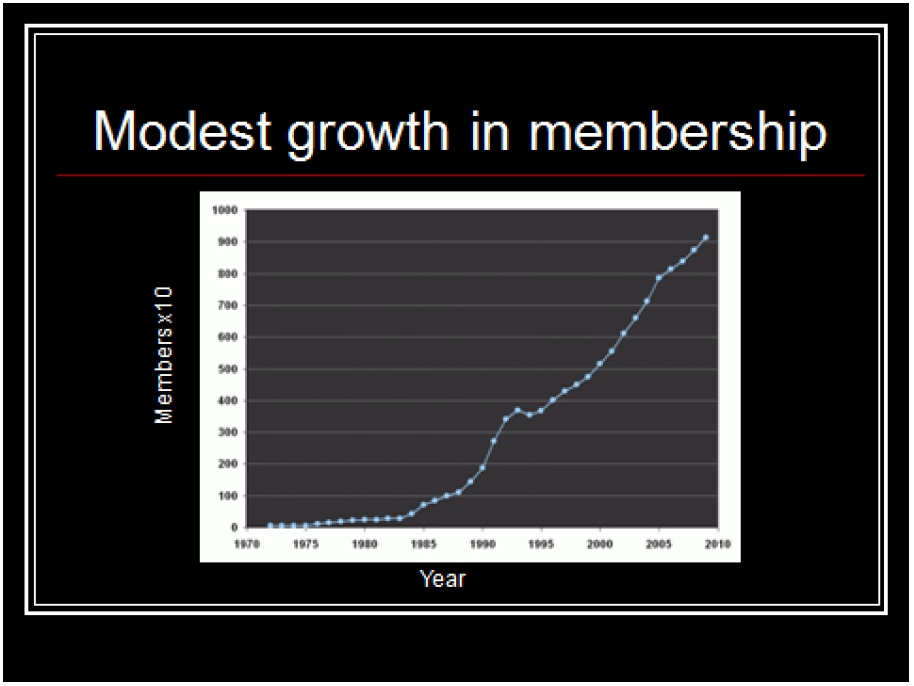
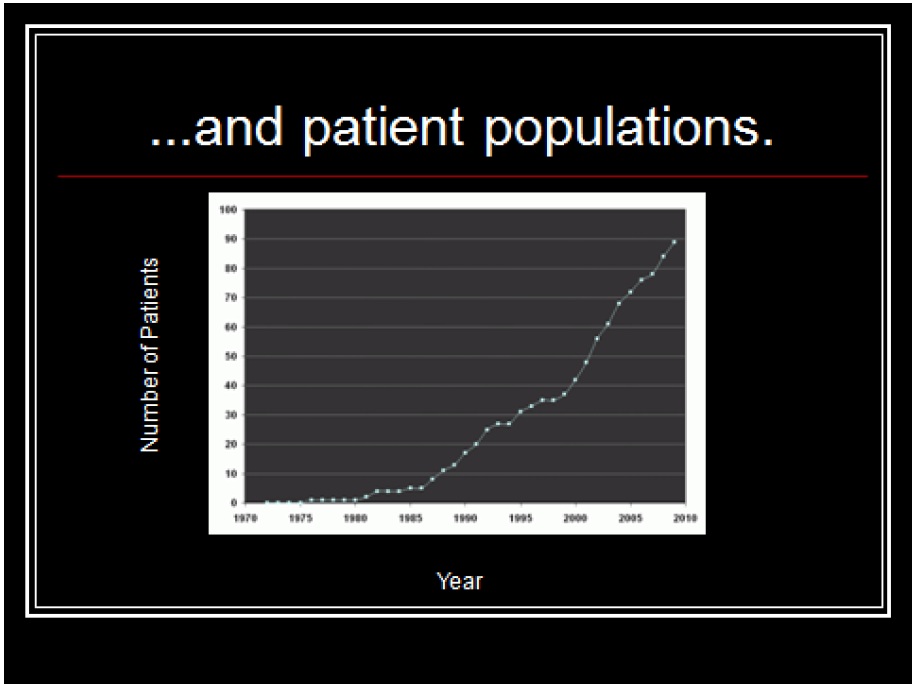
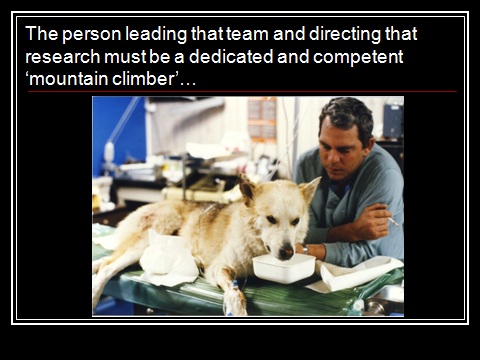
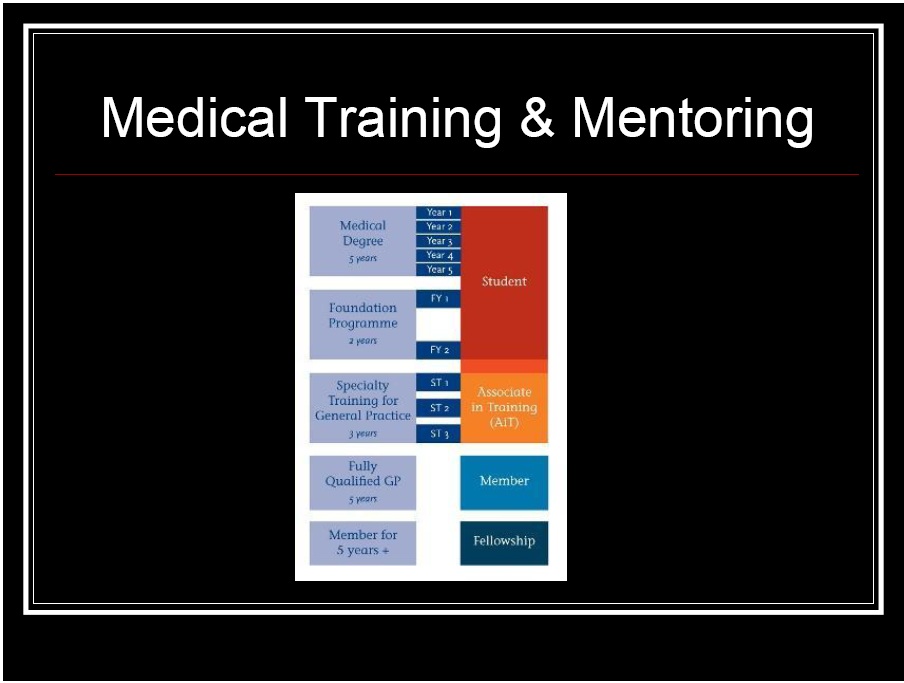

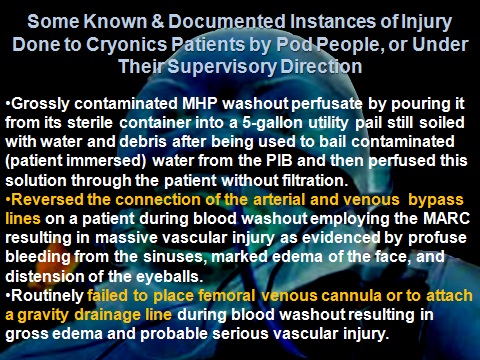

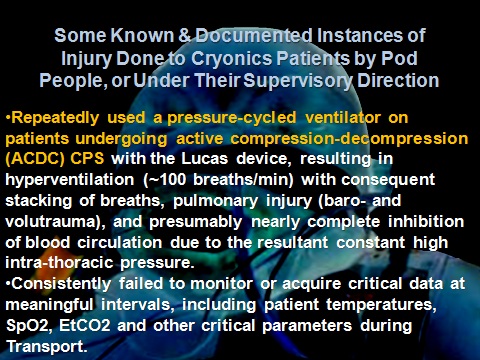
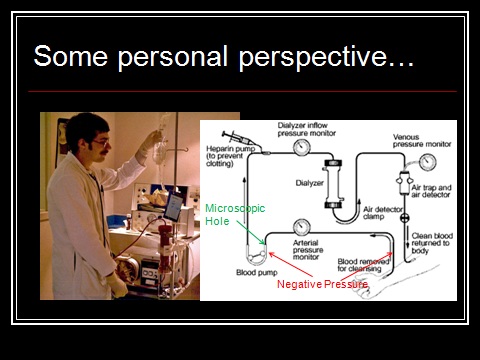

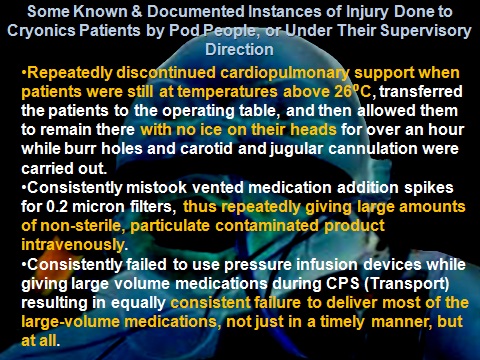
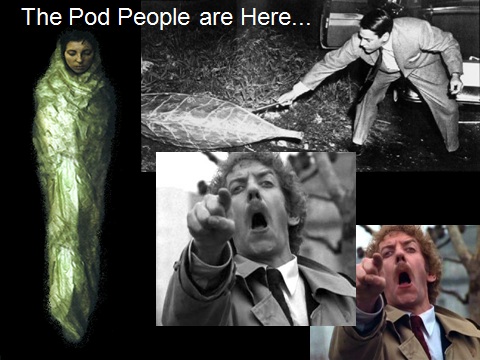


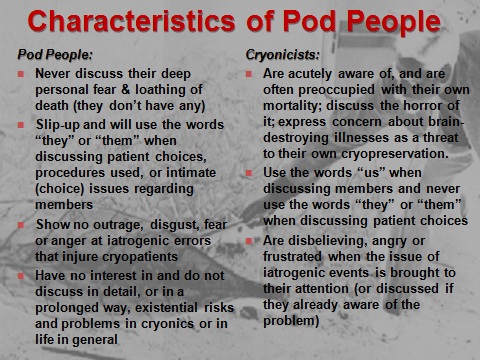

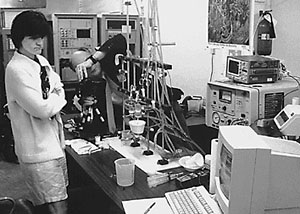

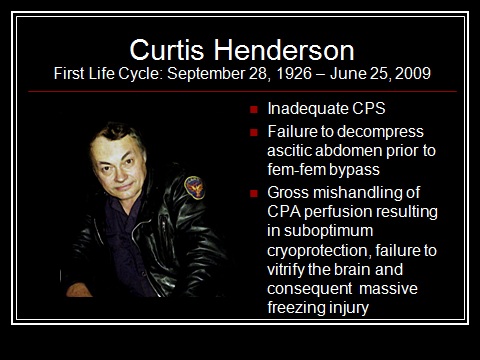
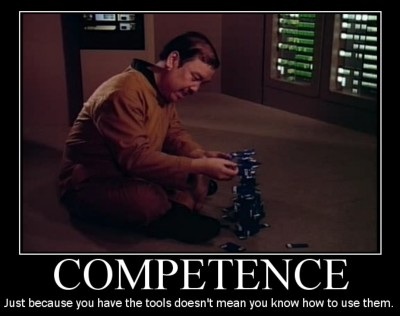
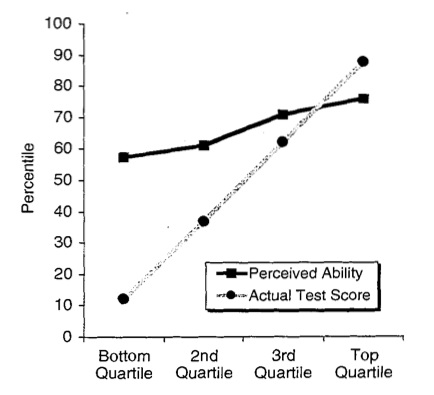
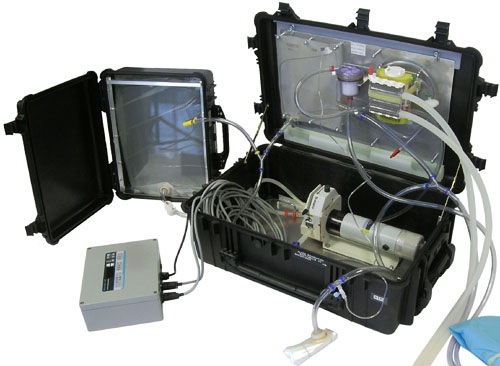

When I left Australia I was a senior biochemist in charge of an analytical laboratory that tested antibiotic pharmaceuticals for the FDA equivalent in Australia, and as an “Official Analyst” was invested with the legal authority to defend such analyses in court. The work was exacting and many people would find its exacting nature boring, especially people with a requirement for novelty and excitement. In the US I worked in drug regulatory affairs for a pharmaceutics company, on the opposite side of the fence. This work too was exacting and meticulous, and had serious legal consequences for the company if it were stuffed up.
As a hirer of staff I read about the psychological attributes of people fitted for this work. High on the list was conscientiousness, being observant, patience, the respect for the need and competence in keeping records, good eye-hand coordination, capable of extended periods of intense concentration and low on arrogance. In training staff, an overall appreciation of the dynamics and pattern of working, the need for scrupulous attention to sterile procedures (bacteria and fungi are used in testing some antibiotics) and the need for organization were paramount. I found bit-by-bit instruction failed, as it did not allow the trainee to understand the reasons behind procedures. Mike trains people well, but I found group training sacrificed detail at times, and sometimes wondered at the benefits as the group dynamic set up in these sessions could be perpetuated. The careful detail-oriented ones are often submerged by the showy lovers of excitement. Careful can become quick, but always-excited people seem in my experience not to be able to slow down, they live in a kind of hazy mix of impervious self confidence and glibness of intellect. I don’t know what you found here, Mike.
Despite all this, there are people who do not have the aptitude for this type of work, and even those who are careful workers can become flustered under pressure of time and circumstance. Repetition is immensely beneficial for work under pressure, especially because one can pick up and rectify mistakes as they happen by a kind of sixth sense, that something in the complex ballet of thought and movement is amiss. People attracted by the potential for excitement are a disaster in waiting.
Since in cryonics willing and competent volunteers are in short supply, we are faced with forming a team of imperfect candidates that will function to people’s strengths. I write this to support Mike’s observations about training while knowing there are quite a few people who will not be able to do this work despite quite a lot of training. I hope I have said more than the “bleeding obvious”.
Mike, since you’ve brought up the psychological characteristics of cryonicists, I’ve noticed a tendency among us to look for ways to become functionally “transhuman” in the here and now, sometimes even before we discovered cryonics, by applying the known science of the time.
For example, Ed Thorp in his book The Mathematics of Gambling writes that during his graduate study of physics in the 1950’s he performed what today’s Millennials would call “body hacking”:
“I had read about the psychology of learning in order to be able to work longer and harder. I found that ‘spaced learning’ worked well: study for an hour, then take a break of at least ten minutes (shower, meal, tea, errands, etc.).”
Others have studied and experimented with body building techniques, special diets, alleged “anti-aging” supplements, cognitive enhancing drugs, psychedelics, fringe philosophies like Objectivism and so forth, instead of leaving their human potentials to the haphazard. Do you have the impression that cryonicists tend to experiment upon themselves to push the envelope more than the general population?
Of course, this tendency can go astray. I know someone on the outskirts of the cryonics movement who suffers from a really bad case of Dunning-Kruger and believes every woo claim he comes across, especially regarding diet and health.
I bring this up because some cryonicists display a weakness for get-rich-quick schemes and dubious fads, which could appeal to the sort of personality already interested in the more empirically grounded forms of life- or body-hacking.